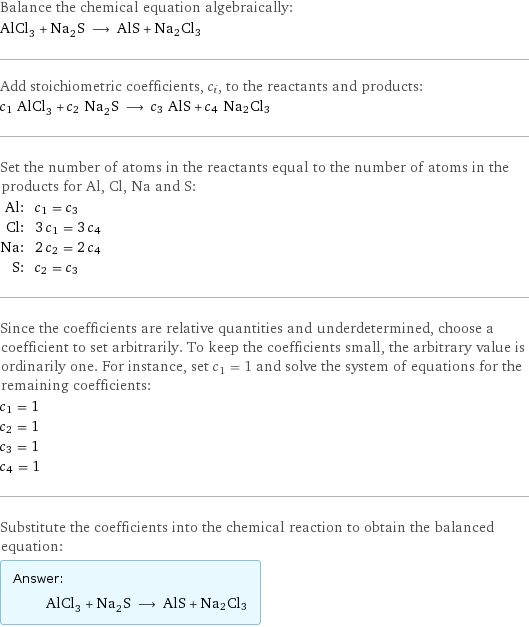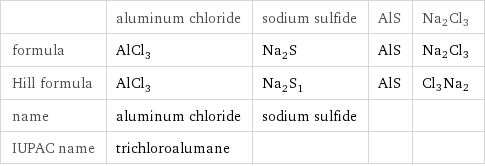Input interpretation

AlCl_3 aluminum chloride + Na_2S sodium sulfide ⟶ AlS + Na2Cl3
Balanced equation

Balance the chemical equation algebraically: AlCl_3 + Na_2S ⟶ AlS + Na2Cl3 Add stoichiometric coefficients, c_i, to the reactants and products: c_1 AlCl_3 + c_2 Na_2S ⟶ c_3 AlS + c_4 Na2Cl3 Set the number of atoms in the reactants equal to the number of atoms in the products for Al, Cl, Na and S: Al: | c_1 = c_3 Cl: | 3 c_1 = 3 c_4 Na: | 2 c_2 = 2 c_4 S: | c_2 = c_3 Since the coefficients are relative quantities and underdetermined, choose a coefficient to set arbitrarily. To keep the coefficients small, the arbitrary value is ordinarily one. For instance, set c_1 = 1 and solve the system of equations for the remaining coefficients: c_1 = 1 c_2 = 1 c_3 = 1 c_4 = 1 Substitute the coefficients into the chemical reaction to obtain the balanced equation: Answer: | | AlCl_3 + Na_2S ⟶ AlS + Na2Cl3
Structures

+ ⟶ AlS + Na2Cl3
Names

aluminum chloride + sodium sulfide ⟶ AlS + Na2Cl3
Equilibrium constant
![Construct the equilibrium constant, K, expression for: AlCl_3 + Na_2S ⟶ AlS + Na2Cl3 Plan: • Balance the chemical equation. • Determine the stoichiometric numbers. • Assemble the activity expression for each chemical species. • Use the activity expressions to build the equilibrium constant expression. Write the balanced chemical equation: AlCl_3 + Na_2S ⟶ AlS + Na2Cl3 Assign stoichiometric numbers, ν_i, using the stoichiometric coefficients, c_i, from the balanced chemical equation in the following manner: ν_i = -c_i for reactants and ν_i = c_i for products: chemical species | c_i | ν_i AlCl_3 | 1 | -1 Na_2S | 1 | -1 AlS | 1 | 1 Na2Cl3 | 1 | 1 Assemble the activity expressions accounting for the state of matter and ν_i: chemical species | c_i | ν_i | activity expression AlCl_3 | 1 | -1 | ([AlCl3])^(-1) Na_2S | 1 | -1 | ([Na2S])^(-1) AlS | 1 | 1 | [AlS] Na2Cl3 | 1 | 1 | [Na2Cl3] The equilibrium constant symbol in the concentration basis is: K_c Mulitply the activity expressions to arrive at the K_c expression: Answer: | | K_c = ([AlCl3])^(-1) ([Na2S])^(-1) [AlS] [Na2Cl3] = ([AlS] [Na2Cl3])/([AlCl3] [Na2S])](../image_source/42fc8439c30a9ae074a4dcc2e3dd92db.png)
Construct the equilibrium constant, K, expression for: AlCl_3 + Na_2S ⟶ AlS + Na2Cl3 Plan: • Balance the chemical equation. • Determine the stoichiometric numbers. • Assemble the activity expression for each chemical species. • Use the activity expressions to build the equilibrium constant expression. Write the balanced chemical equation: AlCl_3 + Na_2S ⟶ AlS + Na2Cl3 Assign stoichiometric numbers, ν_i, using the stoichiometric coefficients, c_i, from the balanced chemical equation in the following manner: ν_i = -c_i for reactants and ν_i = c_i for products: chemical species | c_i | ν_i AlCl_3 | 1 | -1 Na_2S | 1 | -1 AlS | 1 | 1 Na2Cl3 | 1 | 1 Assemble the activity expressions accounting for the state of matter and ν_i: chemical species | c_i | ν_i | activity expression AlCl_3 | 1 | -1 | ([AlCl3])^(-1) Na_2S | 1 | -1 | ([Na2S])^(-1) AlS | 1 | 1 | [AlS] Na2Cl3 | 1 | 1 | [Na2Cl3] The equilibrium constant symbol in the concentration basis is: K_c Mulitply the activity expressions to arrive at the K_c expression: Answer: | | K_c = ([AlCl3])^(-1) ([Na2S])^(-1) [AlS] [Na2Cl3] = ([AlS] [Na2Cl3])/([AlCl3] [Na2S])
Rate of reaction
![Construct the rate of reaction expression for: AlCl_3 + Na_2S ⟶ AlS + Na2Cl3 Plan: • Balance the chemical equation. • Determine the stoichiometric numbers. • Assemble the rate term for each chemical species. • Write the rate of reaction expression. Write the balanced chemical equation: AlCl_3 + Na_2S ⟶ AlS + Na2Cl3 Assign stoichiometric numbers, ν_i, using the stoichiometric coefficients, c_i, from the balanced chemical equation in the following manner: ν_i = -c_i for reactants and ν_i = c_i for products: chemical species | c_i | ν_i AlCl_3 | 1 | -1 Na_2S | 1 | -1 AlS | 1 | 1 Na2Cl3 | 1 | 1 The rate term for each chemical species, B_i, is 1/ν_i(Δ[B_i])/(Δt) where [B_i] is the amount concentration and t is time: chemical species | c_i | ν_i | rate term AlCl_3 | 1 | -1 | -(Δ[AlCl3])/(Δt) Na_2S | 1 | -1 | -(Δ[Na2S])/(Δt) AlS | 1 | 1 | (Δ[AlS])/(Δt) Na2Cl3 | 1 | 1 | (Δ[Na2Cl3])/(Δt) (for infinitesimal rate of change, replace Δ with d) Set the rate terms equal to each other to arrive at the rate expression: Answer: | | rate = -(Δ[AlCl3])/(Δt) = -(Δ[Na2S])/(Δt) = (Δ[AlS])/(Δt) = (Δ[Na2Cl3])/(Δt) (assuming constant volume and no accumulation of intermediates or side products)](../image_source/38f863af71e3ef8c49a4eadbe2953cda.png)
Construct the rate of reaction expression for: AlCl_3 + Na_2S ⟶ AlS + Na2Cl3 Plan: • Balance the chemical equation. • Determine the stoichiometric numbers. • Assemble the rate term for each chemical species. • Write the rate of reaction expression. Write the balanced chemical equation: AlCl_3 + Na_2S ⟶ AlS + Na2Cl3 Assign stoichiometric numbers, ν_i, using the stoichiometric coefficients, c_i, from the balanced chemical equation in the following manner: ν_i = -c_i for reactants and ν_i = c_i for products: chemical species | c_i | ν_i AlCl_3 | 1 | -1 Na_2S | 1 | -1 AlS | 1 | 1 Na2Cl3 | 1 | 1 The rate term for each chemical species, B_i, is 1/ν_i(Δ[B_i])/(Δt) where [B_i] is the amount concentration and t is time: chemical species | c_i | ν_i | rate term AlCl_3 | 1 | -1 | -(Δ[AlCl3])/(Δt) Na_2S | 1 | -1 | -(Δ[Na2S])/(Δt) AlS | 1 | 1 | (Δ[AlS])/(Δt) Na2Cl3 | 1 | 1 | (Δ[Na2Cl3])/(Δt) (for infinitesimal rate of change, replace Δ with d) Set the rate terms equal to each other to arrive at the rate expression: Answer: | | rate = -(Δ[AlCl3])/(Δt) = -(Δ[Na2S])/(Δt) = (Δ[AlS])/(Δt) = (Δ[Na2Cl3])/(Δt) (assuming constant volume and no accumulation of intermediates or side products)
Chemical names and formulas

| aluminum chloride | sodium sulfide | AlS | Na2Cl3 formula | AlCl_3 | Na_2S | AlS | Na2Cl3 Hill formula | AlCl_3 | Na_2S_1 | AlS | Cl3Na2 name | aluminum chloride | sodium sulfide | | IUPAC name | trichloroalumane | | |
Substance properties

| aluminum chloride | sodium sulfide | AlS | Na2Cl3 molar mass | 133.3 g/mol | 78.04 g/mol | 59.04 g/mol | 152.3 g/mol phase | solid (at STP) | solid (at STP) | | melting point | 190 °C | 1172 °C | | density | | 1.856 g/cm^3 | |
Units
